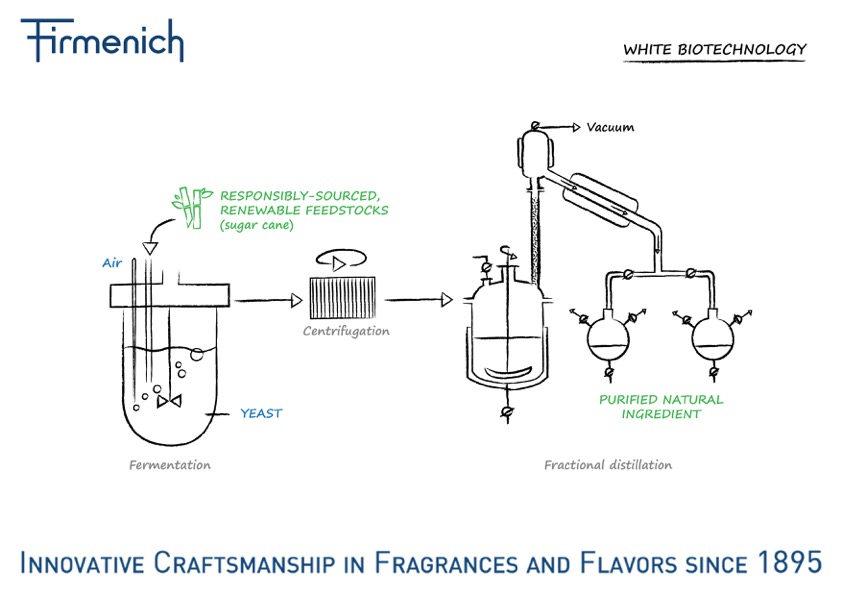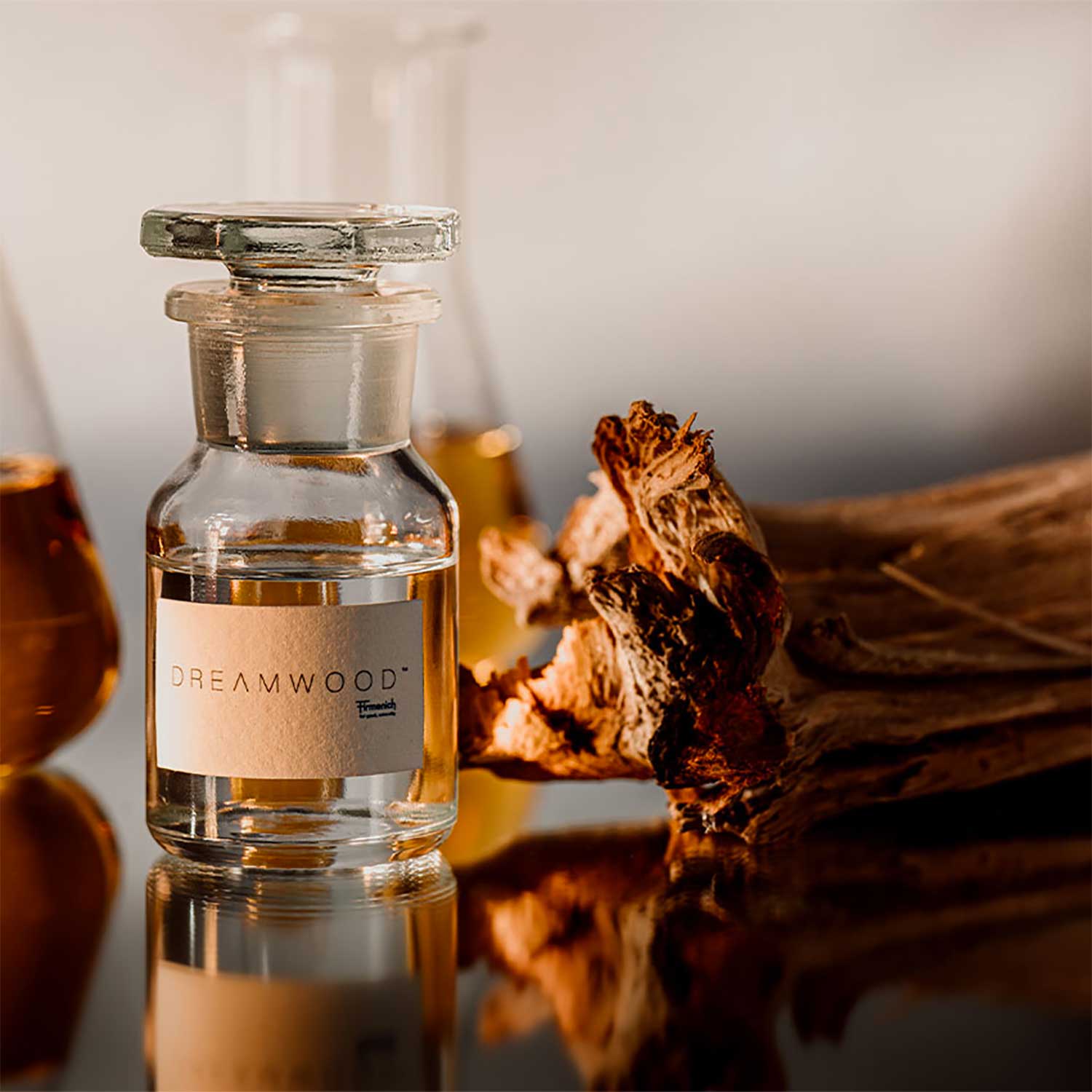Cette publication est également disponible en :
Français
This article was published in partnership with Firmenich.
Firmenich is launching its fourth ingredient created using their white biotechnology, Dreamwood*. Through the alchemy of various substances science and nature have combined to transform sugar into a sandalwood scent.
There are perfumes whose aromas transport us to faraway places; we need only take a few whiffs and we’re in an exotic paradise. A market with flowers and colourful spices which goes on for miles, a temple of carved wood. That’s where sandalwood takes us – it’s the wood that makes us dream.
Sandalwood, originating from Mysore in India, has sadly become a scarcity. The tree, whose perfume is so strong it is said it had the power to calm Shiva, was given royal protection in 1792. Intensive exploitation led the authorities to nationalise plantations, thus preventing any individual from enjoying sandalwood’s sweet perfume. After years of poaching, unsustainable exploitation and corruption the tree almost became extinct and its essence almost disappeared from the perfumer’s palette. However, more recent sustainable plantations can now be found in Australia, which have led to new production of sandalwood essential oil. This initiative is part of the #NaturalsTogether programme run by the Swiss fragrance company Firmenich.
For over fifty years the supply of sandalwood has been a strategic issue for the perfume industry.
Many researchers have studied the scent’s olfactory profile and it was only in the last century that Professor Leopold Ruzicka, former research director at Firmenich, (and winner of the 1939 Nobel Prize for Chemistry) identified the chemical structure of beta-santalol in 1935, one of the main components of the scent.
Work on sandalwood continued after that and in order to respond to the increased demand for natural ingredients, the Firmenich company embarked on an advanced research program to develop a revolutionary technique which is now fifteen years in the making: white biotechnology.

Biotechnology in perfumery
Biotechnology involves making use of the properties contained in microorganisms, particularly enzymes. These proteins act as a catalyst and are essential to every living being. Applied to perfume, biotechnology uses fermentation to transform sugar (cane or beet) into one or several perfume compounds. People have been using bacteria or yeast to transform plant or animal matter since ancient times. Examples include the transformation of grapes into wine and milk into cheese. Microorganisms use their enzymes to react with compounds during the process known as fermentation. The use of sugar contained in molasses is nothing new for distilleries.
Andreas Taglieber, Director of Biochemistry at Firmenich, explains how this transformation takes place in several stages:
It all starts by identifying the key olfactory contributors within a botanical extract. This first step involves an olfactory assessment paired with a chromatography analysis of the extract in its gas state [a physiochemical technique whereby the different substances in a mixture are separated so that they can be identified]. This approach allows us to better understand the olfactory profile of an essential oil and to identify its most important aromatic compounds. In developing Dreamwood we studied sandalwood essential oil and beta-santalol was identified as a key compound among others.
In the next stage, a biochemical analysis allows us to understand how the aromatic molecules in sandalwood essential oil are formed naturally, that is to say what enzymes (or biocatalysts) are involved in their production. In order to carry out such an analysis the key is to use cutting-edge technology such as high-speed DNA sequencing.
Then comes the stage of developing the fermentation process. Once we have identified the enzyme reactions we can start developing the fermentation. This essentially involves optimising several factors such as temperature, stirring and ventilation in order to obtain the required product in the best conditions. Once the microorganism is in the right reproductive conditions, with the correct nutrients (sugar, minerals, oxygen, etc.), fermentation begins and creates one or several new aromatic compounds.
Finally, we carry out the last steps to purify the end product (for example through extraction, distillation or rectification). We are left with a pure molecule, that is to say a mixture that resembles an essential oil.
Numerous advantages
White biotechnology (biotech applied to industrial processes) offers a certain number of technical advantages. It is more cost efficient than an essential oil so the ingredient can be used in other products such as soaps and detergents, and is not just restricted to fine fragrances. This technique also means the quality of the ingredients produced is more consistent, they are 100% carbon renewable and their supply is stable and unlimited. Furthermore, in many cases, white biotechnology consumes less energy and produces less waste than traditional methods. Dreamwood is therefore 100% natural and is biodegradable.
From an olfactory point of view, the ingredient appears to be very similar to the essential oil Santalum album (the botanical variety which was historically the most sought-after by perfumers), whilst at the same time producing a longer-lasting smell. “Dreamwood adds an unexpected element to a perfume’s composition, bringing an aura of brightness, whilst offering the same characteristics as those in a Mysore sandalwood essential oil,” explains Fabrice Pellegrin, Principal Perfumer and Director of Natural Ingredients. “It’s an incredible asset to our palette,” he adds. According to François-Raphaël Balestra, Principal Perfumer and Research Director for New Ingredients, “Dreamwood revives the notes of natural sandalwood for use in modern perfume creations. It gives off a profound smoothness, particularly in the heart and base notes.”
In addition, just like sandalwood essential oil, rigorous laboratory tests have demonstrated that Dreamwood can also be beneficial in a cosmetic application. Indeed, this captive ingredient can bring some of the same cosmetic advantages traditionally associated with sandalwood essential oil. Thanks to its anti-microbial effects and its soothing properties on skin cells Dreamwood may have a positive benefit in skin care products for special needs, including blemishes.
Dreamwood completes the list of ingredients produced by Firmenich Biotechnology, after Clearwood in 2014, a patchouli note, and the biotech versions of their two star ingredients: Z11 and Ambrox Super, both of which have woody notes. “And this is just the beginning,” we are told by Sarah Reisinger, Vice President of Biotech and Process Science at Firmenich. “We are going through an astonishing phase in industrial biotechnology, making major progress in the reading and writing of DNA. Thanks to our increased understanding of how living function, as well as the computing power at our disposal which enables us to analyse large quantities of data, we are quite capable of uncovering hidden treasures in a sea of information,” she tells us enthusiastically.
Wood, spices, lily of the valley… what sugar-based ingredients will the researchers at this Swiss giant come up with next? It’s mindboggling…
*Dreamwood, Clearwood and Ambrox are a Firmenich trademark
To find out more or to request a sample:
www.firmenich.com/dreamwood
Photo Dreamwood : CombyAVm / Firmenich








Comments